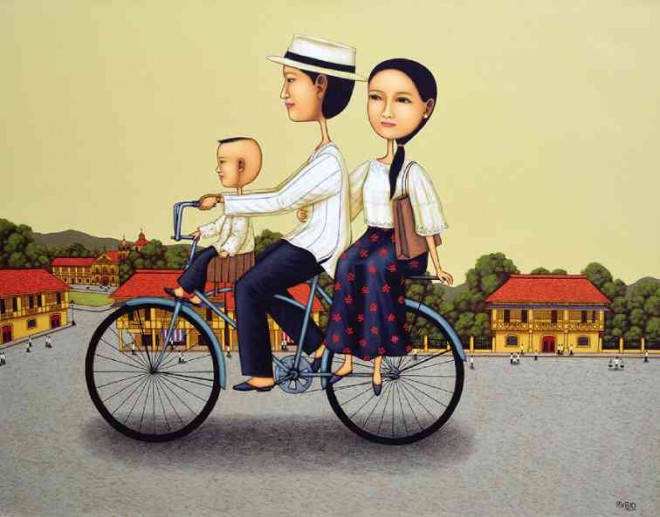
It has been a long journey for Dominic Rubio from his Fine Arts studies at the University of Sto. Tomas to his advertising work, in which at one time he became resident artist of Pearl Farm, the upscale resort in Davao del Sur, and now to his full-time painter’s life.
It was during his work in Mindanao that he found time to learn more about the different tribal communities at the Caraga Region in Northern Mindanao, such as the Mandaya and T’boli tribes, as well as the Badjaos and the B’laans in Southern Mindanao.
He says he was already then sharpening his observation of people, their customs, traditions and manners of living, which would become the essence of his art today.
Rubio’s works are popular among art-lovers. He has developed collectors from the United States, Canada, France, England, Poland, Singapore, Hong Kong and Thailand. He has had major shows in the United States, Canada, Hong Kong and Singapore.
Art critic Reuben Cañete, in his article “Dominic Rubio: Valuing Heritage, Mirroring the Self,” zeroes in on one of the major reasons for Rubio’s success—his capability of making his collectors and his public “see themselves” through his works.
The past as present
Although he paints nostalgic scenes depicting our colonial past, Rubio is actually painting the Filipino today, says Cañete.
Rubio’s paintings, he explains, have “struck a deep chord of nostalgia among his publics, who recollect from these paintings memories of their own recent ancestry, as well as the nascent space of national becoming.
“Viewers retrieve from his paintings a dialectic sense of individual and collective identification that only helps to emphasize the significance of the established present.”
In a word, Rubio is painting the past as present.
Interestingly he uses genres originally developed by artists from our Spanish-colonial past, including the Tipos de Pais, a genre popularized by such artists as Damian Domingo, the founding director of Academia de Dibujo y Pintura de Manila.
In pre-photography days, Domingo painstakingly observed the costumes and mannerisms, economic undertaking and concerns of the populace in 19th-century Philippines.
Rubio paints the taho or bird vendor, the fisherfolk by Pasig River, an illustrado woman promenading in Binondo or Escolta.
‘La Familia Filipina’
In his new exhibit opening Feb. 6, 6:30 p.m., in Galerie Joaquin Main, Rubio presents 30 artworks typifying the Filipino family.
This is a subject truly close to the artist since he’s a family man himself and the father of three children.
Among the artworks are “Carrosa,” “Bisikleta,” “Patungong Maynila (La Familia Filipina),” “Patungong Eskuwela,” “Salop ng Tubig,” all of them showing family members involved in daily tasks. They are all dressed in their finery and ready to go to the big city, preparing to take a trip to the market or church. Rubio is able to elevate the mundane to the extraordinary.
Cañete identifies another colonial artistic technique availed of by Rubio. This is the Miniaturismo, in which “other accoutrements like combs, shoes, hats, rings, kerchiefs and fans,” and other accessories are presented in painstaking detail.
Cañete identifies artists such as Antonio Malantic, Justiniano Asuncion, Dionisio de Castro and Simon Flores as some of Rubio’s precursors. Rubio lavishes particular attention and detail to his subject’s accessories and costumes as well as the architecture in his outdoor settings and the interiors in his indoor.
Another technique that has influenced the artist is the Recuerdos de Fotografo, or colonial photographs—mostly family portraits—recording the activities, concerns and reunions of households and families.
Art critic Cid Reyes praises Rubio’s art as “arresting [for their] the punctilious application of pigment and the delineation of the figures… technically adept, Rubio displays impressive workmanship.”
“La Familia Filipina” is the 12th-anniversary show of Galerie Joaquin, 371 P. Guevarra St., cor. Montessori Lane, Addition Hills, San Juan City. Call tel. 7239418 or 7239253. Visit www.galeriejoaquin.com.